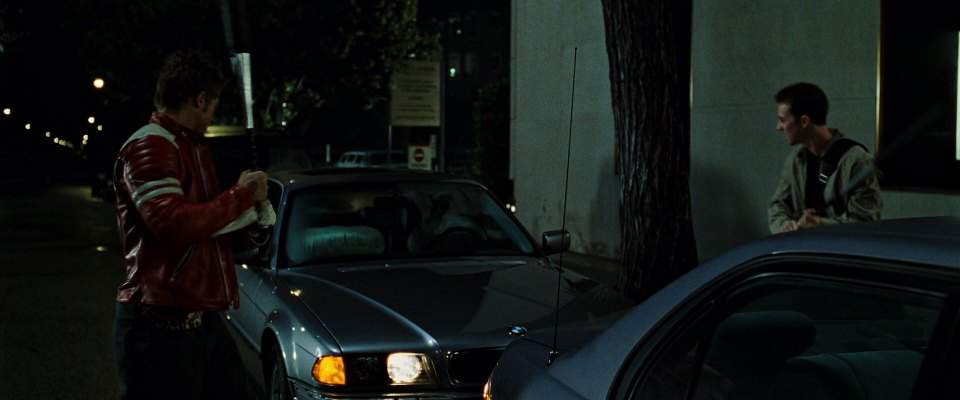Fight Club 1999

An insomniac office worker seeking a way to change his life meets a charismatic soap maker and co-founds an underground fight club as an outlet for repressed anger. As the club's popularity grows, it evolves into something much darker and more chaotic, blurring the lines between reality and illusion. The protagonist finds himself caught in a dangerous game of vengeance, questioning his own identity and the nature of his existence.
Does Fight Club have end credit scenes?
No!
Fight Club does not have end credit scenes. You can leave when the credits roll.
Meet the Full Cast and Actors of Fight Club
Explore the complete cast of Fight Club, including both lead and supporting actors. Learn who plays each character, discover their past roles and achievements, and find out what makes this ensemble cast stand out in the world of film and television.
External Links and Streaming Options
Discover where to watch Fight Club online, including streaming platforms, rental options, and official sources. Compare reviews, ratings, and in-depth movie information across sites like IMDb, TMDb, Wikipedia or Rotten Tomatoes.
Ratings and Reviews for Fight Club
See how Fight Club is rated across major platforms like IMDb, Metacritic, and TMDb. Compare audience scores and critic reviews to understand where Fight Club stands among top-rated movies in its genre.

67
Metascore
8.9
User Score

8.8 /10
IMDb Rating

84
%
User Score
Take the Ultimate Fight Club Movie Quiz
Challenge your knowledge of Fight Club with this fun and interactive movie quiz. Test yourself on key plot points, iconic characters, hidden details, and memorable moments to see how well you really know the film.
Fight Club Quiz: Test your knowledge on the plot, characters, and themes of the 1999 film Fight Club.
What is the first rule of Fight Club?
You do not talk about Fight Club
You must bring your own snacks
Fighting is mandatory
Nobody talks to Marla
Show hint
Awards & Nominations for Fight Club
Discover all the awards and nominations received by Fight Club, from Oscars to film festival honors. Learn how Fight Club and its cast and crew have been recognized by critics and the industry alike.
72nd Academy Awards 2000
Sound Effects Editing
Full Plot Summary and Ending Explained for Fight Club
Read the complete plot summary of Fight Club, including all major events, twists, and the full ending explained in detail. Explore key characters, themes, hidden meanings, and everything you need to understand the story from beginning to end.
The narrator, played by Edward Norton, is an employee of an automobile company who finds himself traveling to various accident sites to conduct cost appraisals for product recalls. His role involves determining whether the financial implications of a recall outweigh the costs associated with compensating claims due to product failures. This pivotal decision directly influences whether a recall is set in motion.
Living in a stark, minimalist apartment reminiscent of an IKEA catalog, the narrator grapples with severe insomnia, having gone six months without a restful night’s sleep. His doctor, rather than prescribing medication, suggests he attend a support group for testicular cancer sufferers to gain perspective on true suffering. While at the group, he becomes emotionally overwhelmed upon witnessing the pain of the others and breaks down, finding solace in the arms of Robert “Bob” Paulson, portrayed by Meat Loaf. This cathartic moment brings him a fleeting sense of relief, allowing him to sleep for the first time in ages. Capitalizing on this newfound comfort, he begins faking ailments to gain access to various support groups, craving the emotional release that helps soothe his restless nights.
However, his fragile routine is upended upon the unsettling realization of another impostor, Marla Singer, played by Helena Bonham Carter, who begins attending the same meetings. The narrator perceives that Marla is merely pretending, and her presence reignites his insomnia and forces him to confront his guilt over the deceit that underpins his attendance. In an effort to reclaim his peace, he arranges for them to attend different meetings, albeit with some reluctance on Marla’s part to exchange contact details.
While on a business trip, the narrator encounters the charismatic Tyler Durden, portrayed by Brad Pitt, a soap salesman with a rebellious spirit. Tyler shares his unconventional wisdom, suggesting that household items can be transformed into explosives. Upon returning home, the narrator is shocked to discover that his apartment has been obliterated in an explosion, suspected to be caused by a gas leak. In the aftermath, he reaches out to both Marla and Tyler, ultimately agreeing to stay with Tyler after their initial bar encounter spirals into a fistfight, marking the beginning of an intense camaraderie.
Tyler’s lifestyle is notably unorthodox; he moonlights as a night shift projectionist, splicing explicit footage into family films, and works at the Pressman Hotel, where he commits various acts of culinary sabotage against affluent patrons. The narrator chooses to live with Tyler in his decrepit house, where the two men frequently engage in brutal fights. This physicality soon evolves into the establishment of Fight Club within the bar’s basement, guided by a set of rules that emphasize secrecy and a pure commitment to the battles that ensue.
As Marla tries to contact the narrator, expressing concern over his absence from support groups, he lies, claiming he has found a new outlet. However, things take a wild turn when he discovers Marla in a compromising situation with Tyler, leaving him bewildered and conflicted. After Marla’s near-fatal Xanax overdose, a bond forms between her and Tyler, while the narrator remains largely out of the loop regarding their increasingly destructive exploits.
With Tyler as the driving force, Fight Club morphs into “Project Mayhem,” an organization dedicated to chaotic, anti-corporate demolition and vandalism across the city. Tensions escalate, leading to a rift between the narrator and Tyler when the latter mysteriously vanishes. As a result of a tragic incident involving Project Mayhem, the narrator embarks on a quest to dismantle the organization he no longer supports. He travels across the country, only to realize that Tyler has infiltrated fight clubs nationwide, to the point where he’s mistakenly identified as Tyler Durden himself.
In a gripping confrontation with his own mind, the narrator learns that Tyler is, in fact, his alter ego—an embodiment of his repressed desires and impulses. This revelation hits him hard, leading to a dramatic showdown where he confronts his fractured identity and the chaos it has wrought. The culmination of these events brings him face to face with the true extent of Tyler’s plans, involving the destruction of the financial institutions that bind society.
When all seems lost, the narrator finds himself in a heart-stopping moment, taking the metaphorical last shot at freedom by firing a gun into his own mouth, which symbolically shatters Tyler’s illusion. Shortly after, Marla is thrust into the situation, captured by Project Mayhem but ultimately left alone with the narrator as they witness, hand in hand, the cataclysmic effects of Tyler’s ambition unfold through the shattered windows, forever changing their world.
Uncover the Details: Timeline, Characters, Themes, and Beyond!

Coming soon on iOS and Android
The Plot Explained Mobile App
From blockbusters to hidden gems — dive into movie stories anytime, anywhere. Save your favorites, discover plots faster, and never miss a twist again.
Sign up to be the first to know when we launch. Your email stays private — always.
Watch Trailers, Clips & Behind-the-Scenes for Fight Club
Watch official trailers, exclusive clips, cast interviews, and behind-the-scenes footage from Fight Club. Dive deeper into the making of the film, its standout moments, and key production insights.
Cars Featured in Fight Club
Explore all cars featured in Fight Club, including their makes, models, scenes they appear in, and their significance to the plot. A must-read for car enthusiasts and movie buffs alike.
Fight Club Themes and Keywords
Discover the central themes, ideas, and keywords that define the movie’s story, tone, and message. Analyze the film’s deeper meanings, genre influences, and recurring concepts.
Fight Club Other Names and Titles
Explore the various alternative titles, translations, and other names used for Fight Club across different regions and languages. Understand how the film is marketed and recognized worldwide.
Articles, Reviews & Explainers About Fight Club
Stay updated on Fight Club with in-depth articles, critical reviews, and ending explainers. Explore hidden meanings, major themes, and expert insights into the film’s story and impact.
Similar Movies To Fight Club You Should Know About
Browse a curated list of movies similar in genre, tone, characters, or story structure. Discover new titles like the one you're watching, perfect for fans of related plots, vibes, or cinematic styles.
Quick Links: Summary, Cast, Ratings, More

What's After the Movie?
Not sure whether to stay after the credits? Find out!
Explore Our Movie Platform
New Movie Releases (2026)
Famous Movie Actors
Top Film Production Studios
Movie Plot Summaries & Endings
Major Movie Awards & Winners
Best Concert Films & Music Documentaries
Movie Collections and Curated Lists
© 2026 What's After the Movie. All rights reserved.




























































